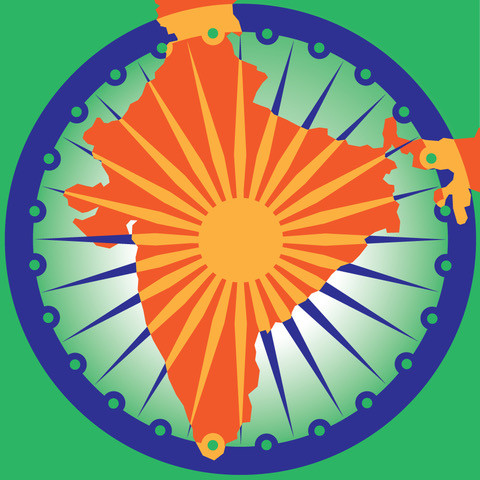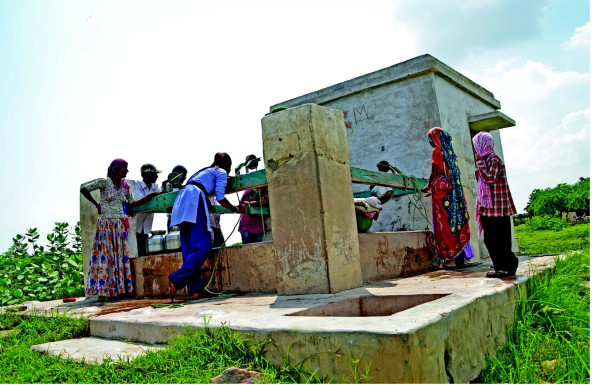
India is in desperate need of more and better water systems capable of meeting the needs of its people. The Indian government estimates that 330 million Indians were affected by drought conditions throughout the country in 2016. To say that the country’s water problems are persistent and considerable would be an understatement.
But according to Rohini Nilekani, founder of Arghyam, a grantmaking foundation focused on water and sanitation in India, the country cannot build water systems like those in the West. Rather, it has to find alternative solutions based on the resources and capacity available in India. “I think we’ve realized that India cannot rely only on surface water,” says Nilekani. “It’s just not ecologically or economically possible. We have to look at groundwater management and reimagine our water infrastructure with that in mind.”
A longtime philanthropist and former journalist, Nilekani began homing in on water projects in 2005. Married to Nandan Nilekani, one of India’s most notable tech entrepreneurs, Rohini has taken a data-driven approach to water and sanitation. She started Arghyam with her own personal endowment in 2001, and since then, the foundation (whose name means “offering” in Sanskrit) has deployed more than INR 120 crores ($18 million) supporting projects and programs in 22 Indian states.
Arghyam has two flagship programs: the India Water Portal (IWP) and the Participatory Groundwater Management program (PGWM). The former serves as a knowledge database for all things pertaining to water. The latter focuses on supporting small communities to manage depleting water resources.
Informing India On Its Water Crisis
Established in 2007, the IWP has attracted a significant following: Available in multiple languages, it receives more than 6,500 visitors on its English-language website and more than 10,700 visitors on its Hindi site each day. The website provides access to working papers, reports, data, articles, news, events, and discussions on water. A team of 20 people spread across India identify local water stories and solutions for the website. Each person focuses on a particular region of the country, producing stories and doing outreach with local press, journalists, and changemakers.
Mala Subramaniam, Arghyam’s CEO, says that the portal has been catalytic in bringing forward stories that otherwise don’t get attention in the media. Consider one IWP report that covered the activities of Ultratech Cement, a mining company in Chhattisgarh that had promised a village jobs, health care, and water. The company didn’t keep its promise; instead, increased mining for limestone has depleted freshwater, leaving villagers to rely on polluted water to irrigate their fields and raise livestock. As Lakhanlal Dhritlahare, a resident of Chhattisgarh, told IWP, “In the 1990s, there were more than 2,500 cattle in our village, but within two decades, their population was reduced by 60 percent due to contaminated water and cattle fodder due to mining activities.”
After IWP published its story about the pollution, print journalists took notice and visited the village to investigate further. The increased media scrutiny compelled Ultratech executives to hold a town hall meeting with the villagers to discuss mitigating measures. Ultimately, the government withdrew Ultratech’s license to operate in the area.
Tushaar Shah, a senior fellow at the International Water Management Institute, says that the portal is “energetic, resourceful, and has a wide usership.” Shah, who has been researching water systems in South Asia for 35 years, is an active user of IWP, referring to it for case studies, literature, and data, and also sharing his own research through the portal.
Local Solutions for Groundwater Management
The World Resources Institute estimates that more than half of India’s groundwater wells are decreasing. That’s leading to more high-risk zones of water in the country where water-related stress is dangerously high. In fact, the national supply of groundwater is predicted to drop 50 percent below demand by 2030. What’s more, as people increasingly move to the city, the need for water systems will become even more acute.
This is why, in recent years, Nilekani has become quite vocal about India’s need to manage its groundwater. Groundwater has been exploited because it’s invisible, pumped from below India’s growing towns and vast agricultural fields, Nilekani explains. “[It’s] a common pool resource. If one uses too much, it affects everyone in the community. But its management doesn’t reflect those common pool principles.”
Nilekani believes that the solution to the groundwater problem lies in simpler, back-to-basics tactics, driven by local resources and populations. “Our hypothesis is that when the right knowledge, or the science of hydrogeology, is provided at the right local level, communities will rally around to build ownership and manage the resource sustainably and equitably,” says Subramaniam.
To that end, Arghyam’s PGWM program is operating in 500 locations around the country. Consider, for example, its work in the village of Randullabad, in Maharashtra. Randullabad sits in a drought-prone region, and three years ago, its drinking water sources were rapidly depleting. Then Arghyam lent its support to a project by the Advanced Center for Water Resource Development and Management, a PGWM partner. The program focused on recharging regional aquifers, geological mapping, testing water quality, and developing usage protocols for drinking and irrigation. It also discouraged farmers from drilling private borewells, which affect water levels in local aquifers and take away from the idea of treating water as a community resource. As a result of the program’s efforts, farmers agreed to use 90 percent of the wells in the communities on a sharing basis. PGWM helped the village go from being on the verge of crisis to self-sufficiency.
The experience of five villages in the northern hilly state of Himachal Pradesh provides another example. While some communities are dealing with water scarcity, these villages were facing a crisis brought on by water contamination. (According to WaterAid, 80 percent of India’s surface water is contaminated, much of it corrupted by untreated sewage.)
It turned out that the five villages, which sit in opposite sides of the valley, shared a common aquifer. Locals from each village didn’t know that they were accessing the same water source as the others; they also didn’t realize that their individual waste practices were infecting the source they all shared. The situation began to improve when PSI, an Arghyam partner, helped put together a cross-valley committee, sharing knowledge about the reasons for the contamination and giving villagers the responsibility of cleaning up their water quality and improving sanitation in the area as a whole.
The participatory nature of these programs means that locals take ownership. They decide how to solve their water problems, and they follow through. Arghyam’s partners are enablers, educating local people on the issues and advising them on best practices.
Challenges Ahead
Creating water programs that work is important, but just as critical is scaling up those programs. To that end, Arghyam tries to get donors and the government to scale up proven practices. The foundation targets the government because 90 percent of funding for development comes from the government, says Subramaniam. Arghyam’s PGWM program has been recognized at the highest levels of government. In 2012, India’s 12th Planning Commission Report (issued every five years by the government) recommended PGWM practices. The Central Groundwater Board has also included PGWM principles in its National Aquifer Mapping Program.
Despite those notable successes, Arghyam still faces significant hurdles when it comes to engaging with the government. “Since the core of our work is about knowledge transfer and building community processes, it has been particularly difficult because government does not know how to manage and monitor the funding for this type of work,” says Subramaniam.
 Residents of Kanmer in Gujarat state use a community well built with Arghyam’s support. (Photo by Usha Deqani Das for India Water Portal, courtesy of Arghyam)
Residents of Kanmer in Gujarat state use a community well built with Arghyam’s support. (Photo by Usha Deqani Das for India Water Portal, courtesy of Arghyam)
For his part, Shah worries that Arghyam’s groundwater program is “too idealist and unrealistic.” He argues that educating farmers on aquifers and local water systems is not likely to create radical change. Rather, he wants to see Arghyam “work towards practical solutions rather than changing the mind-set of farmers.” That means funding innovative solutions. For example, he says there is renewed interest among farmers and governments to convert irrigation tanks into groundwater recharge tanks. “As a foundation, Arghyam can play around with this idea and explore a range of options to improve the tank-groundwater agro-ecology.”
Nilekani, however, believes that Arghyam’s participatory approach has proven that it has great potential, and that small, localized actions can help address India’s water shortage. In fact, she notes, in most of the locations where the PGWM principles have been implemented, the communities have become more “resilient.”
Support SSIR’s coverage of cross-sector solutions to global challenges.
Help us further the reach of innovative ideas. Donate today.
Read more stories by Esha Chhabra.

